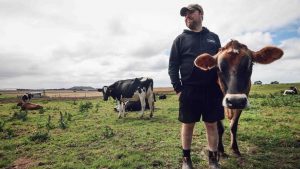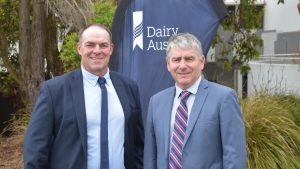
Farmer confidence in the Australian dairy industry is currently in its most stable period in a decade.
Improved weather conditions, a strong milk price and overall stable input costs have provided grounds for profitability, Dairy Australia’s May Situation and Outlook report has revealed.
Eliza Redfern, Dairy Australia’s analysis and insights manager, said the data collected as part of the 2024 National Dairy Farmer Survey indicated that Australian dairy farmers’ confidence remained buoyant.
“Despite increased climate and market volatility over the last four years, the proportion of farming businesses feeling positive about the industry’s future over that time has remained relatively steady, at 68 per cent in 2024,” Ms Redfern said.
“The data also shows that 80 per cent of Australian dairy farmers are feeling positive about their own businesses and back-to-back profitable seasons have led to a growing number reporting they are in a ‘stable and happy’ position.”
The Situation and Outlook report also showed the Australian dairy industry’s milk production is now expected to be higher than previously forecast.
“Australia’s total milk production for the 2023-24 season is now likely to exceed Dairy Australia’s previous forecast, ending this season two to three per cent higher than last season,” Ms Redfern said.
“For the 2024-25 season, Dairy Australia is expecting volumes produced to drop slightly, between zero to one per cent, maintaining a national milk pool around 8.3 billion litres.”
The report said the stabilisation of farm input costs may help mitigate some pressure during the 2024-25 season.
However, a tighter outlook for farm margins will impact farmer confidence and ultimately milk production, while existing challenges around labour and farm exits limit growth more broadly.
In the retail sector, dairy continues to perform well despite the now entrenched cost-saving shopping behaviours of Australian households.
The volume sold of cheese, dairy spreads and yoghurts continues to grow, each increasing between 0.8 and two per cent in the 12 months to March 2024.
The report also confirms that the flow of overseas dairy products into Australia had reduced.
“Australian dairy markets may still be under pressure from international product both globally and domestically, but Australia’s imports of overseas dairy products are slowing,” Ms Redfern said.
“Over the season-to-date from July to February 2024, import data shows 7.4 per cent less product has crossed the border compared to the same period last season.”
After some initial recovery leading into 2024, global dairy commodity markets are still searching for balance between supply and demand pressures.
Lacklustre demand for dairy continues to limit commodity price increases.
Therefore, stagnant global supply will likely provide underlying support for dairy export commodity prices in the near term.
For more information and to view the latest Situation and Outlook report visit: https://dairyaustralia.com.au/sando
You can now read the most important #news on #eDairyNews #Whatsapp channels!!!
🇺🇸 eDairy News INGLÊS: https://whatsapp.com/channel/0029VaKsjzGDTkJyIN6hcP1K

























